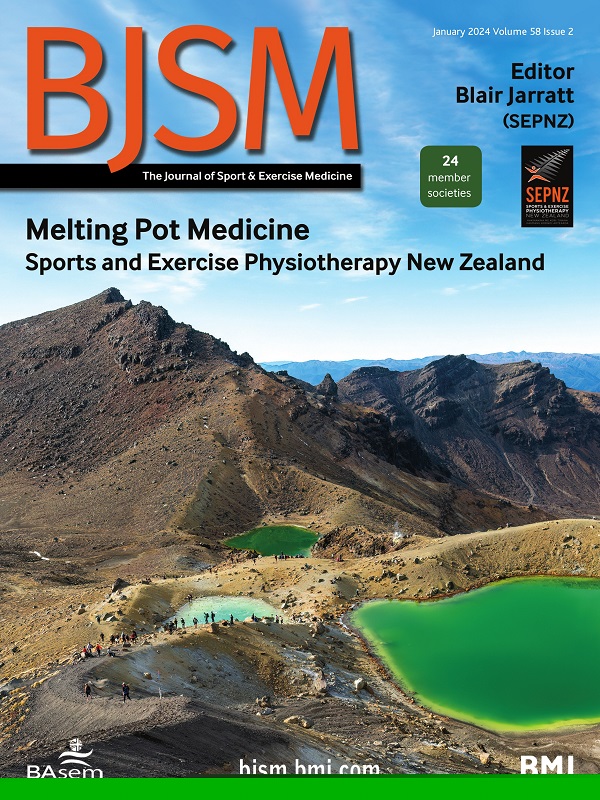MRI筛查年轻男性板球快速保龄球运动员腰椎骨应力性损伤:一项15年回顾性队列研究
IF 16.2
1区 医学
Q1 SPORT SCIENCES
引用次数: 0
摘要
目的MRI筛查越来越多地用于精英板球的腰椎骨应激性损伤(lbsi)的早期检测。然而,它对受伤结果和职业轨迹的影响尚不清楚。本研究评估了年轻男性快速保龄球运动员LBSI的短期和长期结果,比较了通过MRI筛查检测到的损伤与临床检测到的损伤。方法回顾性队列研究分析了英格兰和威尔士板球委员会15年(2009-2024)的损伤监测数据。男性快速保龄球运动员(16-24岁)的lbsi分为筛查检测(通过常规MRI)或临床检测(症状发作后影像学证实)。通过短期(诊断至恢复比赛(RTP))和长期(RTP后5年)时间框架对结果进行评估。结果142例保龄球运动员(平均损伤年龄19.4±2.1岁)共检出lbsi 197例(筛查检出44例,临床检出153例)。筛查检测到的损伤更可能是应激反应(p=0.002),而完全骨折则完全是临床检测到的。筛查检测到的损伤有更短的RTP时间(p<0.001),保守管理的RTP成功率为100%。筛查发现受伤的保龄球运动员在赛季中的可用性更高(p<0.001),并且在rtp后恢复到受伤前的比赛标准。5年后,51%-67%的保龄球运动员没有再损伤,两种检测方法的概率相当(p≥0.536);两组的5年游戏标准轨迹均有改善。结论与基于症状的途径相比,MRI筛查可能有助于早期发现lbsi,实现保守管理,缩短RTP时间和更高的可用性,同时允许持续的职业发展。然而,观察到的再损伤风险突出了改进预防策略的必要性。无数据。本文章由计算机程序翻译,如有差异,请以英文原文为准。
MRI Screening for lumbar bone stress injuries in young male cricket fast bowlers: a 15-year retrospective cohort study
Objective MRI screening is increasingly used in elite cricket to support the early detection of lumbar bone stress injuries (LBSIs). However, its impact on injury outcomes and career trajectories remains unclear. This study evaluated short-term and long-term outcomes from LBSI in young male fast bowlers, comparing injuries detected through MRI screening with those detected clinically. Methods This retrospective cohort study analysed 15 years (2009–2024) of injury surveillance data from the England and Wales Cricket Board. LBSIs in male fast bowlers (aged 16–24) were classified as screening-detected (via routine MRI) or clinically-detected (imaging-confirmed following symptom onset). Outcomes were evaluated across short-term (diagnosis to return-to-play (RTP)) and long-term (5-year post-RTP) timeframes. Results 197 LBSIs (44 screening-detected, 153 clinically-detected) were detected in 142 bowlers (mean age at injury: 19.4±2.1 years). Screening-detected injuries were more likely to be stress reactions (p=0.002), while complete fractures were exclusively clinically-detected. Screening-detected injuries had shorter RTP times (p<0.001) and were managed conservatively with 100% RTP success. Bowlers with screening-detected injuries had greater in-season availability (p<0.001) and returned to preinjury playing standards post-RTP. Over 5 years, 51%–67% of bowlers remained reinjury-free, with comparable probabilities between detection methods (p≥0.536); 5-year playing standard trajectories showed improvement in both groups. Conclusion MRI screening may facilitate earlier detection of LBSIs compared with symptom-based pathways, enabling conservative management, shorter RTP times and greater availability, while allowing for continued career progression. However, the observed risk of reinjury highlights the need for improved preventive strategies. No data are available.
求助全文
通过发布文献求助,成功后即可免费获取论文全文。
去求助
来源期刊
CiteScore
27.10
自引率
4.90%
发文量
217
审稿时长
3-8 weeks
期刊介绍:
The British Journal of Sports Medicine (BJSM) is a dynamic platform that presents groundbreaking research, thought-provoking reviews, and meaningful discussions on sport and exercise medicine. Our focus encompasses various clinically-relevant aspects such as physiotherapy, physical therapy, and rehabilitation. With an aim to foster innovation, education, and knowledge translation, we strive to bridge the gap between research and practical implementation in the field. Our multi-media approach, including web, print, video, and audio resources, along with our active presence on social media, connects a global community of healthcare professionals dedicated to treating active individuals.

 求助内容:
求助内容: 应助结果提醒方式:
应助结果提醒方式:


